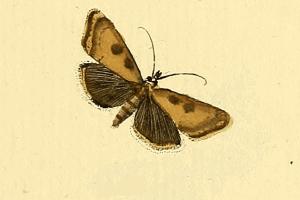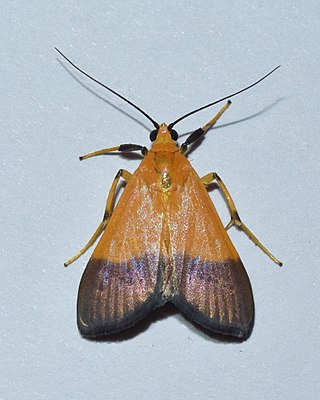
The Pyralidae, commonly called pyralid moths, snout moths or grass moths, are a family of Lepidoptera in the ditrysian superfamily Pyraloidea. In many classifications, the grass moths (Crambidae) are included in the Pyralidae as a subfamily, making the combined group one of the largest families in the Lepidoptera. The latest review by Eugene G. Munroe and Maria Alma Solis retain the Crambidae as a full family of Pyraloidea.

The Pyraloidea are a moth superfamily containing about 16,000 described species worldwide, and probably at least as many more remain to be described. They are generally fairly small moths, and as such, they have been traditionally associated with the paraphyletic Microlepidoptera.
Atralata is a genus of moths of the family Crambidae. It contains only one species, Atralata albofascialis, which is found in most of Europe, except Ireland, Great Britain, Norway, Finland, Lithuania and Greece.

Hellula undalis, the cabbage webworm or Old World webworm, is a moth of the family Crambidae. It is a widespread species which is found from Europe across Asia to the Pacific. It was first described from Italy.
Albusambia is a genus of moths of the family Crambidae. It contains only one species, Albusambia elaphoglossumae, which is found in Central America, where it has been recorded from the Costa Rican San José and Cartago Provinces at altitudes between 2,300 and 3,100 meters.

Pococera robustella, the pine webworm moth, is a species of moth of the family Pyralidae. It is found in southern Canada and the eastern United States from Minnesota to New England and south to Florida.
Trachonitis cristella is a species of snout moth in the genus Trachonitis. It was described by Michael Denis and Ignaz Schiffermüller in 1775, although some sources attribute it to Jacob Hübner. It is found in much of Europe, including Portugal, France, Germany, Switzerland, Austria, Italy, Poland, the Czech Republic, Slovakia, Hungary, Croatia, Bosnia and Herzegovina, North Macedonia, Greece, Romania, Ukraine and Russia.

Pima boisduvaliella is a species of snout moth. It is found in most of Europe, Asia, including Mongolia and Kazakhstan and northern North America, including Alberta.

Udea institalis is a species of moth in the family Crambidae. It is found in Spain, France, Italy, Greece, the Republic of Macedonia, Romania, Slovakia, Ukraine and Russia.

Udea nebulalis is a species of moth in the family Crambidae. It is found in France, Switzerland, Austria, Italy, Germany, Poland, the Czech Republic, Slovakia, Slovenia, Croatia, Bosnia and Herzegovina, Serbia and Montenegro, Bulgaria, Romania, Estonia and Fennoscandia.

Pyrausta aerealis is a species of moth in the family Crambidae described by Jacob Hübner in 1793. It is found in most of Europe. It has also been recorded from Kyrgyzstan, Kazakhstan, Afghanistan, China and Algeria.

Dentifovea fulvifascialis is a species of moth in the family Crambidae. It is found in Greece, Lebanon, Israel and India.' The larvae feed Heliotropium rotundfolium and probably other Heliotropium species. They mine the leaves of their host plant. Larvae can be found in May.

Epascestria pustulalis is a species of moth in the family Crambidae. It is found in large parts of Europe, except Ireland, Great Britain, Norway, Finland, Denmark, the Benelux, France, Switzerland, Portugal, Slovenia and Croatia. It is also present in the Near East, including Lebanon and Turkey.
Mecyna trinalis is a species of moth in the family Crambidae. It is found in France, Spain, Italy, Austria, the Czech Republic, Slovakia, Poland, Hungary, the Balkan Peninsula, Ukraine, Russia, Turkey and North Africa, including Algeria and Morocco.

Herpetogramma phaeopteralis, commonly known as the dark sod webworm, is a species of moth in the family Crambidae. It was described by Achille Guenée in 1854.
Herpetogramma stultalis is a species of moth in the family Crambidae. It was described by Francis Walker in 1859. It is found in Malaysia, India, Sri Lanka, China, Japan, Pakistan, Papua New Guinea and Australia, where it has been recorded from Queensland. In Africa, it has been recorded from the Democratic Republic of the Congo and Réunion.
Omiodes poeonalis is a moth in the family Crambidae. It was described by Francis Walker in 1859. It is found in the Democratic Republic of the Congo, Sierra Leone, Tanzania, the Chagos Archipelago, China, Indonesia, Sri Lanka, Japan and Australia (Queensland).
Palpita metallata is a moth in the family Crambidae. It is found in Cameroon, Mayotte, Democratic Republic of Congo, Ghana, Kenya, Nigeria, Sierra Leone, South Africa, Tanzania and Uganda.

Ulopeza conigeralis is a species of moth in the family Crambidae. It was described by Philipp Christoph Zeller in 1852. It is found in Cameroon, the Republic of the Congo, the Democratic Republic of the Congo, Equatorial Guinea, Ethiopia, Ghana, Ivory Coast, Mali, Nigeria, Sierra Leone, South Africa and Zambia.
Zebronia phenice is a moth in the family Crambidae. It was described by Stoll in 1782. It is found in Cameroon, Mayotte, the Democratic Republic of Congo, Equatorial Guinea, Ethiopia, Gabon, Ghana, Ivory Coast, Kenya, La Réunion, Madagascar, Mauritius, Mozambique, Nigeria, Senegal, Sierra Leone, South Africa, Tanzania, Gambia, Uganda, Zambia and Zimbabwe.










